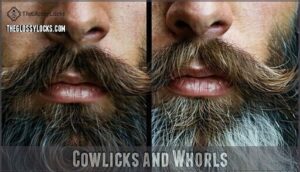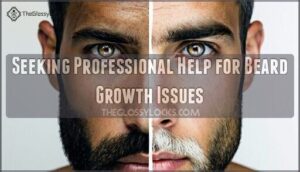This site is supported by our readers. We may earn a commission, at no cost to you, if you purchase through links.

Think of it like your body’s blueprint—it’s rarely perfectly symmetrical. Hormonal fluctuations, particularly testosterone and DHT levels, affect each side differently.
Your sleeping position also plays a role since you’re likely crushing one side against your pillow nightly, disrupting blood flow to those follicles. Even your dominant hand matters—you probably touch or scratch one side more often.
Stress levels and diet influence growth patterns too, creating uneven development. While genetics set the stage, understanding the underlying mechanisms reveals several practical solutions for achieving better balance.
Table Of Contents
- Key Takeaways
- Why Does My Beard Grow More on One Side?
- Understanding Beard Growth Patterns
- Causes of Uneven Beard Growth
- Hacks to Fix Uneven Beard Growth
- Diet for Beard Growth
- Beard Care Tips
- Common Beard Growth Direction Issues
- Tips for Managing Different Beard Growth Directions
- Seeking Professional Help for Beard Growth Issues
- Frequently Asked Questions (FAQs)
- Why does my beard grow unevenly?
- Why does my beard grow differently on one side?
- Why does my beard look thicker on one side?
- Can beard hair grow longer on one side?
- Is it normal for a beard to grow sideways?
- How does a beard grow?
- How do you fix uneven beard growth?
- Why is my beard only growing on one side?
- How to fix sideways growing beard?
- Does no beard mean low testosterone?
- Conclusion
Key Takeaways
- Your genetics control beard asymmetry – You cannot change your DNA, but you can work with it by understanding that uneven follicle distribution and hormone sensitivity differences between sides are completely normal.
- Hormones and lifestyle habits create imbalances – Your testosterone levels, sleep position, stress, and diet all affect how each side grows, so managing these factors helps to even out your beard over time.
- Strategic grooming fixes visual differences – You will get better results by growing your beard longer to mask patches, trimming the fuller side to match the shorter one, and using beard oil to nourish weaker areas.
- Patience beats quick fixes – Your facial hair cycles take several weeks to show improvements, so consistent care with proper products and techniques will deliver better long-term results than temporary cosmetic tricks.
Why Does My Beard Grow More on One Side?
Your beard’s playing favorites with one side, and there’s solid science behind this facial hair asymmetry.
Genetics and beard growth patterns run deep in your DNA, determining everything from follicle sensitivity to dihydrotestosterone levels.
Hormonal influence creates uneven beard growth when testosterone distribution varies across your face.
Sleep habits matter too – constantly sleeping on one side restricts blood flow and creates patchy growth.
Stress hormones can throw off your hormonal imbalance, while poor diet starves follicles of essential nutrients.
This beard growth imbalance affects facial symmetry, but understanding the root causes puts you in control of finding solutions.
Understanding Beard Growth Patterns
Your facial hair’s uneven beard isn’t random—it’s controlled by beard genetics and facial structure.
Each hair follicle operates independently through distinct growth cycles: anagen (growing), catagen (transitioning), and telogen (resting).
This creates facial hair asymmetry since follicles aren’t synchronized. Hormone balance influences these beard growth patterns, while follicle angles—determined genetically—cause some hairs to grow sideways or curl back.
Understanding these natural cycles explains your patchy beard and beard growth difference between sides.
It’s biology, not bad luck. Factors like beard growth stages influence growth rates and play a significant role in the development of facial hair.
Causes of Uneven Beard Growth
Your beard’s uneven growth stems from several interconnected factors that affect hair follicle development and hormone distribution across your face.
Understanding these root causes—from genetic predisposition to lifestyle habits—helps you target the right solutions for achieving better facial hair symmetry.
Genetic Factors
Your genetic influence acts like a blueprint that determines everything about your facial hair.
These hereditary traits control follicle density, hormone levels, and growth patterns inherited from both parents.
Genetic variation explains why your left side might flourish while your right side struggles—it’s written in your DNA.
Beard growth genetics create natural asymmetry that’s completely normal.
Your genetic factors determine how sensitive follicles are to testosterone, causing uneven beard growth.
Since you can’t rewrite your genes, understanding this helps you work with your natural beard symmetry instead of fighting it.
Stress
Beyond genetics, stress acts as a silent saboteur of your beard’s symmetry.
When you’re overwhelmed, your body releases cortisol and other stress hormones that disrupt hair follicle function, leading to patchy beard growth and uneven beard growth patterns. This creates a hormonal imbalance that directly affects your beard growth patterns.
Effective stress management requires a multi-pronged approach:
- Mindfulness exercises – Practice daily meditation or deep breathing
- Regular physical activity – Exercise reduces cortisol levels naturally
- Consistent sleep schedule – Aim for 7-9 hours nightly
- Relaxation techniques – Try progressive muscle relaxation or yoga
Achieving emotional balance and prioritizing mental health isn’t just good for your well-being—it’s essential for that symmetrical, full beard you’re after.
Diet and Exercise
Poor nutritional factors directly sabotage your beard growth rate, creating noticeable imbalances between sides.
Your facial hair growth depends heavily on vitamins and minerals like biotin, zinc, and vitamin D.
A balanced diet rich in protein fuels follicle health, while regular exercise routines boost circulation to hair roots.
These healthy habits and fitness plans aren’t just good for your body—they’re essential nutrition tips for evening out patchy growth patterns.
Hormonal Imbalances
When your hormonal imbalances disrupt beard growth, you’re dealing with a complex system.
Your thyroid function, adrenal glands, and pituitary work together controlling hair development.
Low testosterone and erratic testosterone levels directly impact hormone regulation, while DHT effects determine follicle sensitivity.
Genetics influence how your body responds to these hormonal shifts.
If one side of your face receives different hormonal signals due to hormonal imbalance, uneven growth follows naturally.
Professional evaluation helps identify underlying issues.
Hacks to Fix Uneven Beard Growth
While genetics largely determines your beard’s uneven growth pattern, you can use targeted grooming techniques to improve symmetry and create the appearance of balanced facial hair.
These evidence-based methods work by manipulating hair direction, enhancing sparse areas, and optimizing follicle health to minimize visible differences between both sides of your face, using techniques that improve symmetry.
Grow Beard Long
Sometimes the simplest solution works best. Growing your beard long masks uneven beard growth more effectively than any quick fix.
Longer beard length naturally conceals patchy areas where follicle health varies between sides. Different growth cycles mean some hairs lag behind others, but extended growth allows slower areas to catch up.
Beard density appears more uniform when hair reaches sufficient length. Hair texture also becomes less noticeable in longer beards.
This approach works especially well for genetic factors and hormonal imbalance issues causing your patchy beard.
Use a beard brush regularly to train whiskers. Utilizing beard growth products can also enhance the overall health and appearance of your beard.
Trim Sideburns and Neckline
Precision trimming transforms your uneven beard into a masterpiece of facial hair symmetry.
Once you’ve grown out your beard, strategic sideburn styling and neckline shaping become your secret weapons against patchy facial hair and irregular beard growth patterns.
Here’s your step-by-step approach to achieve perfect beard symmetry:
- Sideburn styling: Trim sideburns to match your beard’s natural length, creating seamless shifts that disguise uneven growth
- Neckline shaping: Position your neckline two fingers above your Adam’s apple using clean, precise cuts
This targeted trimming approach redirects attention from patchy areas while establishing clean boundaries. Your beard growth patterns will appear more uniform, and those stubborn cowlicks won’t stand a chance against proper neckline definition and strategic sideburn management.
Use Beard Oil or Balm
Beard oil transforms your patchy beard from scraggly to spectacular.
This liquid gold delivers essential hair nourishment straight to your follicles, promoting healthier beard growth.
Beard conditioning with quality oils like jojoba or argan creates ideal beard hydration, making sparse areas appear fuller.
Apply 3-4 drops daily, massaging into skin beneath your whiskers.
Oil benefits include reduced irritation and improved texture, while balm effects add styling control.
These beard care tips target uneven beard growth by creating ideal conditions for consistent development.
Regular use of beard care products can enhance the overall appearance of your beard.
Exfoliate Beard
Skin renewal through beard exfoliation tackles uneven beard growth by removing dead skin cells that block hair follicles.
You’re basically giving your facial hair a fresh start. Create a gentle scrub using coconut oil and sugar, then massage it into your beard once or twice weekly.
This facial massage stimulates blood flow and awakens dormant follicles, promoting healthier beard growth direction. The process helps correct facial hair imbalance by encouraging patchy areas to fill in naturally, improving overall beard health.
Regular beard exfoliation techniques are vital for maintaining a healthy and balanced beard growth pattern.
Eyebrow Pencil Trick
After thorough exfoliation, cosmetic tricks like the eyebrow pencil trick provide instant beard camouflage for patchy beard growth.
This hair concealer method addresses facial asymmetry while your follicles catch up.
- Select an eyebrow pencil matching your natural beard color exactly
- Apply gentle, hair-like strokes following your beard growth direction
- Blend edges seamlessly for natural-looking facial fillers effect
- Seal with clear balm for lasting beard shaping results
The process involves using the eyebrow pencil to create a more even appearance, and then sealing it with clear balm to make the results last, achieving a natural-looking facial fillers effect.
Diet for Beard Growth
Your beard needs specific nutrients to grow evenly, and what you eat directly affects hair follicle health and keratin production.
A diet rich in protein, biotin, zinc, and vitamins A, C, and D provides the building blocks your facial hair requires to develop symmetrically on both sides, which is crucial for symmetrical growth.
Essential Vitamins and Nutrients
Fixing uneven growth goes beyond grooming tricks—your body needs the right fuel. Vitamin deficiency can sabotage your beard goals before you even start. Focus on nutrient balance through targeted supplementation and smart food choices.
Vitamin B5 supports healthy follicle function, while vitamin D regulates hair growth cycles. Biotin benefits include stronger, thicker strands that fill patchy areas. Don’t overlook iron supplements if you’re deficient—low iron creates weak, brittle facial hair.
Your zinc intake directly impacts testosterone production and follicle health. These vitamins and nutrients work together, creating the foundation for symmetrical growth. Biotin deserves special attention since it’s your beard’s best friend for consistent thickness. A balanced diet rich in beard growth vitamins is essential for maintaining healthy beard growth.
Importance of Protein and Zinc
Your beard’s building blocks depend heavily on protein intake and zinc supplements for ideal facial hair growth.
These nutrients fuel hair strength and support the hormone production that drives beard growth factors.
Here’s your nutrient balance gameplan:
- Boost protein with lean meats, eggs, and legumes to meet dietary needs
- Load up on zinc through oysters, pumpkin seeds, and beef
- Consider supplements if your diet falls short
- Consult your doctor before adding zinc supplements to avoid overdoing it
Beard Care Tips
Your daily beard care routine directly impacts follicle health and can reduce the appearance of uneven growth patterns.
Proper maintenance techniques help optimize blood flow to hair follicles while preventing damage that worsens asymmetrical growth.
Avoiding Harsh Products
When choosing products for your uneven beard, harsh chemicals can sabotage your progress faster than you’d think.
Alcohol-based formulas strip away natural oils that protect against patchy beard issues and hormonal imbalances.
Instead, reach for gentle shampoos and mild conditioners that won’t irritate your skin or disrupt growth patterns.
Natural oils, beard balms, and hair serums work with your follicles, not against them.
This approach to avoiding harsh products supports healthier beard maintenance while preventing the inflammation that often worsens uneven beard growth, promoting a more natural way to care for your beard.
Regular Moisturizing
Beyond using gentle products, your facial hair craves regular moisturizing to achieve balanced growth.
Think of beard hydration like watering a garden—consistent care yields better results than sporadic attention.
Beard oil penetrates deep into follicles, delivering essential hair nourishment while preventing the flaky, itchy skin that disrupts growth patterns.
Quality moisturizing tips include applying products to damp facial hair for better absorption.
Natural ingredients like jojoba oil and shea butter excel at skin care without clogging pores.
This consistent facial hair maintenance helps correct uneven beard issues by creating ideal growing conditions on both sides of your face.
Using the right beard care products can make a significant difference in beard health and appearance.
Using Beard Comb or Brush
Daily beard comb and beard brush sessions work like physical therapy for your facial hair.
You’ll stimulate follicles while redistributing natural oils that prevent uneven beard growth. Choose wooden combs or boar-bristle brushes for ideal hair alignment and follicle stimulation.
Start combing from your neckline upward when dry, training stubborn hairs into proper beard growth direction.
These comb techniques and brush benefits transform chaotic whiskers into organized beard styling perfection.
Regular Trimming
Most men deal with uneven beard patterns, but regular trimming becomes your secret weapon for achieving balance.
Trimming techniques matter more than frequency—work with damp hair using quality trimming tools to prevent snagging different hair texture areas.
Your asymmetrical beard growth follows unique beard cycles, so trim conservatively every two weeks rather than aggressive cuts.
Focus follicle care through gentle, upward strokes that respect natural growth directions.
Smart beard maintenance means trimming less from your slower-growing side while evening out the fuller areas for symmetrical results.
Managing Stress and Sleep
Tackle stress and poor sleep patterns head-on—they’re sabotaging your beard’s potential.
High cortisol levels from chronic stress create hormonal imbalance, while inadequate sleep disrupts testosterone production, both causing uneven beard growth.
Transform your routine with these calming exercises:
- Practice mindful breathing for 10 minutes daily to lower cortisol
- Maintain 7-8 hours of sleep to optimize hormone production
- Try relaxation techniques like meditation to reduce stress-induced inflammation
Common Beard Growth Direction Issues
Your beard’s growth direction stems from genetically determined hair follicle angles, which can cause hairs to grow sideways, curl back, or point in different directions on each side of your face.
These directional variations, combined with natural cowlicks and follicle density differences, create the uneven appearance that makes one side look fuller or longer than the other, due to the overall follicle density.
Patchy Beard Growth
Patchy growth frustrates many men, but it’s surprisingly common.
Your beard genetics determine follicle density and placement, creating natural gaps that affect facial symmetry.
Uneven beard growth occurs when follicles enter different growth cycles simultaneously.
Hair texture variations also contribute to asymmetrical beard growth patterns.
Most beard patchiness improves with time as slower follicles catch up.
Focus on follicle health through proper nutrition and patience.
Understanding hormone imbalance effects can also help address the root causes of patchy beards.
Remember, even celebrities deal with uneven beards—you’re not alone in this journey.
Cowlicks and Whorls
Beyond patchy spots, cowlicks and whorls create their own beard challenges.
These Hair Whorls form when follicles grow at different angles, causing Facial Asymmetry and uneven beard growth. Your genetics determine these Cowlick Patterns, affecting Beard Texture and Growth Directions.
Here’s how to identify common patterns:
- Circular whorls creating spiral formations
- Opposing beard growth direction at jawline
- Sideways-growing hairs disrupting flow
- Multiple cowlicks forming irregular patches
Understanding these patterns helps you work with, not against, your natural growth.
Strategies for Even Growth
When dealing with uneven beard growth, strategic beard trimming can create facial symmetry by evening out longer sections.
Target specific hair follicles with minoxidil to stimulate patchy areas, while beard care products like oils nourish weaker spots.
Understanding your natural growth patterns helps you work with, not against, asymmetrical beard growth for better results.
Tips for Managing Different Beard Growth Directions
Your beard follicles don’t follow a master plan, and different growth directions on each side of your face are completely normal due to genetic programming.
You can train these rebellious hairs using targeted grooming techniques, strategic product application, and precise trimming methods that work with your natural growth patterns rather than against them, which involves understanding and working with your natural growth patterns.
Proper Grooming Techniques
Proper grooming techniques transform your uneven beard from chaos to control.
Regular beard trimming creates symmetry, while facial massage boosts blood flow to follicles.
Train hair alignment through consistent brushing patterns.
Master these grooming tools for ideal beard styling:
- Boar bristle brush – Distributes oils evenly across follicles
- Quality trimmer – Maintains precise length control
- Beard scissors – Targets individual unruly hairs
- Derma roller – Stimulates dormant follicles
- Wide-tooth comb – Prevents breakage during styling
Using Beard Products
Strategic product selection transforms your beard game.
Beard oils nourish follicles and soften coarse hairs, while beard balms provide hold for stubborn patches.
Beard waxes tackle flyaways, and beard creams offer lightweight control.
Choose products based on your beard’s density and growth patterns.
Daily application of quality beard products creates consistency, helping both sides appear fuller and more uniform through proper beard grooming.
Trimming and Shaping
A well-executed beard trimming routine transforms uneven growth into polished facial symmetry.
Start by identifying your dominant growth side, then use precise shaping techniques to create visual balance. Trimming against the grain helps control stubborn follicles, while strategic beard styling with graduated lengths masks irregularities.
Address uneven sideburns by trimming the fuller side to match the shorter one. Understanding beard growth cycles helps you time cuts effectively.
Master these beard trimming techniques and hair alignment becomes second nature. Your asymmetrical nightmare becomes a symmetrical dream with consistent practice.
Seeking Professional Help for Beard Growth Issues
Sometimes your beard growth issues persist despite trying every DIY trick in the book, and that’s when you’ll need to call in the experts.
A dermatologist can identify underlying hormonal imbalances, skin conditions like folliculitis, or genetic factors that cause persistent uneven growth patterns on one side of your face.
Recognizing Persistent Problems
Sometimes beard asymmetry stubbornly persists despite your best grooming efforts.
When uneven sideburns and patchy growth continue after months of proper care, it’s time to recognize deeper issues.
Facial hair that suddenly changes growth patterns or develops persistent bare spots may signal underlying health concerns.
A constantly tangled, unmanageable beard often indicates follicle damage from neglect or harsh products.
One-sided beard growth that worsens over time, especially with skin irritation or unusual beard unevenness causes, warrants professional evaluation to fix uneven beard growth effectively.
Understanding beard growth problems is essential for addressing these persistent issues.
Dealing With Ingrown Hairs and Infections
When persistent problems arise beyond basic grooming issues, ingrown hair and follicle infections can seriously derail your beard growth journey.
These pesky bumps don’t just hurt—they create uneven patches that throw off your entire look.
Hair bumps form when curved hairs curl back into the skin, causing inflammation and those telltale red welts.
Left untreated, these can develop into full-blown infections that leave permanent scarring.
Here’s your action plan for skin irritation management:
- Gentle exfoliation removes dead skin cells that trap hairs beneath the surface
- Warm compress application reduces swelling and draws out embedded hairs naturally
If redness treatment at home isn’t cutting it, don’t tough it out.
A dermatologist can prescribe targeted antibiotics and professional extraction techniques to get your follicles back on track.
Addressing Severe Growth Direction Changes
Dramatically altered beard growth direction signals deeper issues requiring professional intervention.
When hair follicle orientation shifts severely, dermatologists can identify underlying causes affecting growth patterns and facial asymmetry.
| Warning Signs | Professional Solutions |
|---|---|
| Sudden direction changes | Hormone therapy assessment |
| Persistent beard unevenness | Targeted follicle treatments |
| Failed home remedies | Advanced trimming techniques |
They’ll diagnose root causes and recommend specialized treatments for ideal beard alignment.
Frequently Asked Questions (FAQs)
Why does my beard grow unevenly?
Your beard grows unevenly due to genetics controlling follicle placement, hormone levels, and growth patterns.
Hair follicles cycle through different stages independently, creating natural asymmetry that’s completely normal for most men, due to the fact that genetics also influence the hormone levels.
Why does my beard grow differently on one side?
Around 90% of men experience asymmetrical facial hair growth.
Your beard’s uneven pattern stems from genetics controlling follicle density, hormone sensitivity, and growth direction.
Each side’s follicles operate independently, creating natural differences you can’t control, which is influenced by genetics.
Why does my beard look thicker on one side?
Your beard’s thicker appearance on one side stems from genetics controlling follicle density and hair growth patterns.
Different growth stages, hormonal variations, and sleeping habits can create asymmetrical thickness that’s completely normal.
Can beard hair grow longer on one side?
Like a garden with varying soil conditions, your beard’s asymmetrical growth stems from genetics controlling follicle density, hormone sensitivity, and growth cycles.
Each side’s follicles operate independently, creating natural length differences you’ll notice, which is influenced by genetics.
Is it normal for a beard to grow sideways?
Yes, sideways beard growth is completely normal.
Your hair follicles naturally grow at different angles due to genetics, creating varied directions.
This follicle positioning determines whether hairs grow straight down or sideways across your face.
How does a beard grow?
It’s like a symphony of tiny hair follicles working independently.
Your beard grows through cycles—anagen (growth), catagen (transition), and telogen (rest)—influenced by genetics, hormones like testosterone, and follicle sensitivity to dihydrotestosterone (DHT).
How do you fix uneven beard growth?
You can’t completely fix genetic uneven growth, but you can manage it.
Trim longer sections to match shorter areas, use beard oil for nourishment, and let it grow longer to camouflage differences naturally.
Why is my beard only growing on one side?
Your beard’s one-sided growth isn’t coincidence—it’s genetics playing favorites.
Hair follicles on each side develop independently, influenced by testosterone sensitivity and blood flow patterns.
This asymmetrical growth is completely normal and often evens out over time.
How to fix sideways growing beard?
Train your sideways-growing hairs by brushing them in your desired direction daily.
Use beard balm to hold stubborn hairs in place, and trim strategically to create symmetry while follicles adjust to new growth patterns.
Does no beard mean low testosterone?
Don’t jump to conclusions—patchy facial hair doesn’t automatically signal low testosterone.
Genetics primarily control beard growth patterns, while hormone levels, follicle sensitivity, age, and ethnicity all play significant roles in determining your facial hair destiny.
Conclusion
Understanding why your beard grows more on one side empowers you to take targeted action.
Your follicles respond differently to hormonal fluctuations, genetic programming, and environmental factors like sleep position.
The five fixes—growing longer, strategic trimming, using quality products, proper exfoliation, and temporary cosmetic solutions—address these underlying mechanisms.
With consistent application of these evidence-based techniques, you’ll achieve more balanced growth patterns.
Remember, patience remains key since facial hair cycles take several weeks to show noticeable improvements in symmetry, and it is crucial for achieving balanced growth.
















